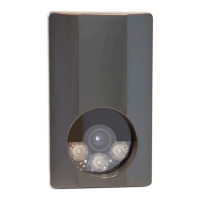ANPR
© Nedap AVI, P.O. Box 103, NL-7140 AC GROENLO Page 19 of 27
5.2.6.4 ACTION: SEND MESSAGE TO RS485 SERIAL PORT
It is possible to send messages to the RS485 serial port. Tags are used to define the content of the message sent.
Before using the serial ports, it is necessary to configure them in a web page found in the system section. See
chapter 5.3.3. See chapter 4.3 for details about connecting the RS485 serial interface.
Enable: Select YES to enable sending messages to the RS485 serial port.
Message: Specify the message content syntax. This is done using tags. Click the Help-button to
check the supported tags. It is possible to inserts bytes using hexadecimal coding.
This makes data packet building more flexible than when using alphanumeric
characters only.
For example: in order to send the number plate number string followed by the two
character sequence CR (carrier return) and LF (line feed) as terminators, the message
field is to be set as follows: %PLATE%0x0D%0x0A where 0x0D and 0x0A are the
hexadecimal codes of CR and LF, respectively.
5.2.6.5 ACTION: SEND MESSAGE TO TCP/IP SOCKET
If enabled, this action will send a message to a TCP/IP socket connection. Tags are used to define the content of
the message sent. See chapter 4.1 for details about connecting the TCP/IP ethernet interface.
See the ANPR ethernet programmer's guide which describes the TCP/IP message data format.
Enable: Select YES to enable sending messages to a TCP/IP socket.
Message: Specify the message contents. This is done using tags. Click the Help-button to check
the supported tags. It is possible to insert in the packet either data (such as number
plate number, date and time) or the JPEG image of the vehicle: %IMAGE_BW.
The data is sent on the network using a message header that includes the overall
number of data contained in the message.
Jpeg Quality: Jpeg image quality. The value may range from 1 to 100 where 1 is the maximum
compression level (lowest quality) and 100 is the minimum compression level
(highest image quality). Suggested values from 50 to 90.
Server IP: IP address of the server.
Server Port: Server listening port.
Reuse Connection: NO: the socket connection is opened and closed upon every message.
YES: the socket connection is opened upon sending the first message and is kept
active. The connection is shut down if unused for 15 minutes.
Regardless of mode configuration, the TCP connection will close and open a new TCP
connection when problems occurred while sending data. This means the receiver
should be steadily ready to accept new TCP connections.
Buffering on SD: In case of network failure and Buffering on SD is enabled, the camera will save all
data regarding the actions. When the network connection is restored, the ANPR will
manage automatically all data stored, freeing the memory. The saving is based over a
circular buffer. In case of full memory the ANPR will overwrite oldest data.

